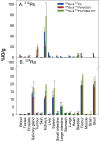In situ Generated 212Pb-PSMA Ligand in a 224Ra-Solution for Dual Targeting of Prostate Cancer Sclerotic Stroma and PSMA-positive Cells
- PMID: 32389119
- PMCID: PMC7527546
- DOI: 10.2174/1874471013666200511000532
In situ Generated 212Pb-PSMA Ligand in a 224Ra-Solution for Dual Targeting of Prostate Cancer Sclerotic Stroma and PSMA-positive Cells
Abstract
Background: New treatments combating bone and extraskeletal metastases are needed for patients with metastatic castration-resistant prostate cancer. The majority of metastases overexpress prostate-specific membrane antigen (PSMA), making it an ideal candidate for targeted radionuclide therapy.
Objective: The aim of this study was to test a novel liquid 224Ra/212Pb-generator for the rapid preparation of a dual-alpha targeting solution. Here, PSMA-targeting ligands are labelled with 212Pb in the 224Ra-solution in transient equilibrium with daughter nuclides. Thus, natural bone-seeking 224Ra targeting sclerotic bone metastases and 212Pb-chelated PSMA ligands targeting PSMA-expressing tumour cells are obtained.
Methods: Two PSMA-targeting ligands, the p-SCN-Bn-TCMC-PSMA ligand (NG001), specifically developed for chelating 212Pb, and the most clinically used DOTA-based PSMA-617 were labelled with 212Pb. Radiolabelling and targeting potential were investigated in situ, in vitro (PSMA-positive C4-2 human prostate cancer cells) and in vivo (athymic mice bearing C4-2 xenografts).
Results: NG001 was rapidly labelled with 212Pb (radiochemical purity >94% at concentrations of ≥15 μg/ml) using the liquid 224Ra/212Pb-generator. The high radiochemical purity and stability of [212Pb]Pb- NG001 were demonstrated over 48 hours in the presence of ascorbic acid and albumin. Similar binding abilities of the 212Pb-labelled ligands were observed in C4-2 cells. The PSMA ligands displayed comparable tumour uptake after 2 hours, but NG001 showed a 3.5-fold lower kidney uptake than PSMA- 617. Radium-224 was not chelated and, hence, showed high uptake in bones.
Conclusion: A fast method for the labelling of PSMA ligands with 212Pb in the 224Ra/212Pb-solution was developed. Thus, further in vivo studies with dual tumour targeting by alpha-particles are warranted.
Keywords: 212Pb; 224Ra/212Pb-liquid generator; NG001; PSMA-617; TCMC; metastatic castration-resistant prostate cancer; targeted alpha therapy.
Copyright© Bentham Science Publishers; For any queries, please email at epub@benthamscience.net.
Figures






References
-
- Garashchenko B.L., Korsakova V.A., Yakovlev R.Y. Radiopharmaceuticals based on alpha emitters: preparation, properties, and application. Phys. At. Nucl. 2018;81(10):1515–1525. doi: 10.1134/S1063778818100071. - DOI
MeSH terms
Substances
LinkOut - more resources
Full Text Sources
Other Literature Sources
Medical
Miscellaneous

